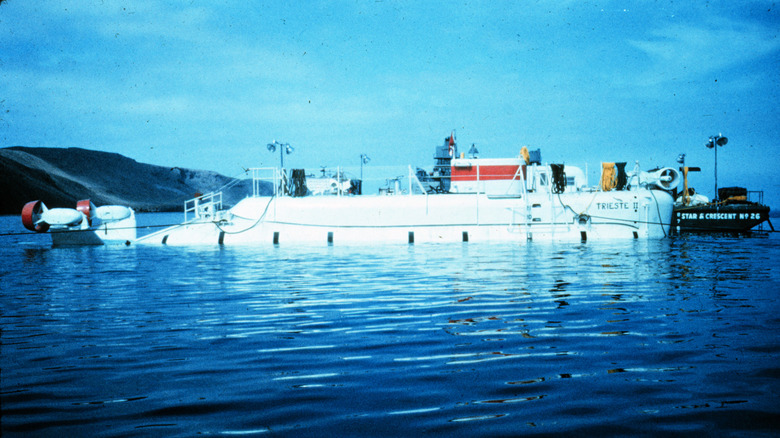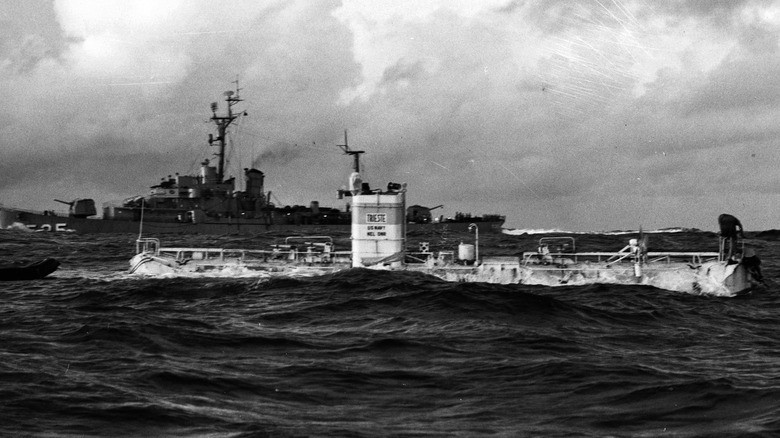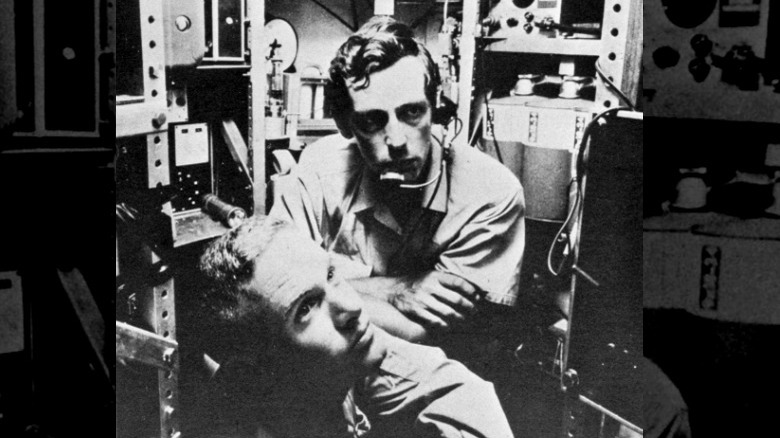The First Crewed Vessel To Reach The Deepest Point In The Ocean
Humanity has dreamed about the unknown expanse hidden under the ocean's depths even before Jules Verne's prophetic 1870 novel "Twenty Thousand Leagues Under the Sea." In the same way that humanity has craned its neck upwards to chart the cosmos, people have gazed below to discover what lies at the bottom of the ocean. Many ships had been designed over the years to resist the immense pressure of the ocean depths. However, it would be the Trieste, a bathyscaphe built by Swiss engineer Auguste Piccard, that would eventually venture where no one had gone before.
Bathyscaphes were designed specifically for deep-sea navigation and to withstand the crushing pressure from the deep sea, which could crush an ordinary submarine like a soda can (via UCSB Science Line). The Trieste began exploring the Mediterranean Sea in 1953, but it wasn't until Uncle Sam took notice in 1958 that its full potential was realized (per Naval History and Heritage Command).
At the time, the U.S. Navy hoped that the Trieste would participate in Project Nekton, a military-funded initiative to reach the Challenger Deep, the ocean's deepest point (via University of Delaware College of Marine Studies). This urge to explore the ocean's depths parallels the creativity of the famed Cold War "Space Race," in which the U.S. and Soviet Union competed for technological supremacy. Despite the one-sided nature of this affair, the fact that the U.S. Navy paid $250,000 (about $2.5 million in today's dollars) underlines their desire to be seen as deep-sea pioneers (per Chicago Tribune). However, if the Trieste was to reach such depths, it would require considerable fine-tuning first.
If at first you don't succeed
The Trieste would be tweaked over the following year to reach deeper locations, but it inevitably had to be tested. On October 5, 1959, the Trieste was hoisted aboard the Santa Mariana freighter, and the two ships set sail towards Guam, where the Mariana Trench is located (per "To the Ocean Deep” by Valerie Bodden, posted at the Internet Archive).
Over the following weeks, the Trieste made many daring attempts to reach the ocean's deepest point, yet always fell a little short. Each failure provided invaluable insights. On November 15, the Trieste broke the world's previous record, reaching an astounding depth of 18,150 feet (via Naval History and Heritage Command). However, the crew reported a heart-stopping bang from the Trieste when it expanded and strained to cope with the pressure of these unprecedented depths. The crew, presumably horrified, discovered that minor volumes of water had leaked into the ship after docking, although it was nothing that a little glue and mechanical rings couldn't fix (via U.S. Naval Institute).
Continuing the crew's success, the seventh attempt saw the Trieste reach an incredible 23,950 feet before the crew's safety became jeopardized. The Trieste was just 50 feet from the Nero Deep when it was forced to return owing to further booms, lights shattering, and a pipe's collapse. The crew later discovered that the gasoline valves had also been damaged in the attempt (per U.S. Naval Institute). The Trieste needed apertures that could actively relieve part of the pressure, the crew discovered. With this in mind, the stage for the eventual record-breaking dive was set.
Success at last!
The final and most death-defying dive took place early the following year, on January 23, 1960. The Trieste, manned by Navy officer Don Walsh and oceanographer Jacques Piccard, the son of the Trieste's creator, plunged beneath the waves to shatter their record (via Rolex). Before that, the two-man team had some support from the U.S. Navy in pinpointing the Mariana Trench's deepest point. To compensate for the absence of high-tech surveying technology, the Navy comically resorted to dropping bombs into the trench and measuring the time it took for explosions to occur. Surprisingly, it would need 300 explosions to be certain (via Don Walsh, posted at the U.S. Naval Institute).
Everything went off without a hitch until the Trieste had reached roughly 29,527 feet. Coping with the pressure, a windowpane of Plexiglass on the Trieste cracked yet remained in place. However, due to this new imbalance, the vessel shook severely. Miraculously though, the Trieste stabilized, and the duo stayed down there for 20 minutes (per "To the Ocean Deep" by Valerie Bodden).
Due to the lack of light, the temperature aboard the Trieste plummeted to 45 degrees Fahrenheit. The duo claimed they passed the time by peering out the window with a flashlight and gazing at sea creatures drifting by (per Scientific American). When it became clear that the crew was in grave danger, the Trieste began its ascent to the surface, and three hours later, the crew returned unscathed. History was born.
Aftermath and Legacy
Aside from smashing all deep-water oceanic exploration records, the Trieste's courageous expedition taught humanity a lot about the perils of deep-sea diving. Not only did it astound the world, but this accomplishment also challenged the consensus that humans could neither travel to nor survive at such depths. It's equally mind-boggling to consider that both Walsh and Piccard achieved this astounding accomplishment without the aid of high-tech supercomputers, which are now ubiquitous in many military submarines and naval vessels worldwide. For nearly five decades, the Trieste was the first and only manned vehicle to successfully traverse such depths of the Mariana Trench, until the Deepsea Challenger voyage in 2012 (via National Geographic).
In a bizarre twist of fate, the Deepsea Challenger was designed for a solo traveler and remarkably, the director of the 1997 film "Titanic," James Cameron, would be just the man for the job. The Deepsea Challenger managed to reach 35,787 feet in its mission, per NPR. While Cameron's endeavor is unquestionably impressive, it cannot be overstated how revolutionary and inspiring the Trieste's achievements were in the first place.
Walsh and Piccard were not just the first humans to set their sights on the Challenger Deep, something Jules Verne and Jacques' own father, Auguste Piccard, could only dream of. They also shifted the goalposts of what human ingenuity, and imagination could achieve. As such, their names deserve to be remembered by inquisitive humans for the rest of time.



